Biochar Improves Greenhouse Tomato Yield: Source–Sink Relations under Deficit Irrigation
Abstract
:1. Introduction
2. Materials and Methods
2.1. Description of the Study Site
2.2. Experimental Materials
2.3. Experimental Design
2.4. Measurement and Methods
2.4.1. Source Characteristic
Leaf Area
Leaf Soil Plant Analysis Development (SPAD)
Net Photosynthetic Rate (Pn)
Leaf Weight Per Plant (LWPP)
2.4.2. Sink Characteristic
2.4.3. Sink–Source Ratio
2.5. Statistical Analysis
3. Results
3.1. Effects of Biochar on Tomato Source Characteristics under Deficit-Irrigation
3.1.1. Leaf Area
3.1.2. SPAD
3.1.3. Net Photosynthetic Rate (Pn)
3.1.4. Leaf Weight per Plant (LWPP)
3.2. Effects of Biochar on Tomato Sink Characteristics under Deficit-Irrigation
3.2.1. Stem Weight per Plant (SWPP) and Root Weight per Plant (RWPP)
3.2.2. Fruit Weight per Plant (FWPP) and its Composition
3.3. Effects of Biochar on the Sink–Source Ratio of Tomato under Deficit-Irrigation
3.4. Source–Sink Mechanism of Tomato Yield Formation
3.4.1. Effects of Biochar on Greenhouse Tomato Yield in Deficit-Irrigation
3.4.2. Source and Sink Mechanism Path Analysis for Greenhouse Tomato Yield Formation
4. Discussion
4.1. The Compensatory Effects of Biochar on the Adverse Effects of Tomato Source and Sink Characteristics under Deficit-Irrigation Conditions
4.2. Response of Tomato Source–Sink Characteristics to Biochar Addition under Different Irrigation Levels
4.3. Source–Sink Mechanism of Tomato Yield Formation
5. Conclusions
Author Contributions
Funding
Data Availability Statement
Acknowledgments
Conflicts of Interest
References
- Wang, H.; Xiang, Y.; Zhang, F.; Tang, Z.; Guo, J.; Zhang, X.; Hou, X.; Wang, H.; Cheng, M.; Li, Z. Responses of yield, quality and water-nitrogen use efficiency of greenhouse sweet pepper to different drip fertigation regimes in Northwest China. Agric. Water Manag. 2022, 260, 107279. [Google Scholar] [CrossRef]
- Zhou, X.; Li, J.; Zeng, Y.; Xin, L. Present condition and change of facility agriculture land in China under the background of rural revitalization. Land Nat. Resour. Res. 2019, 1, 15–20. [Google Scholar]
- Gorni, P.H.; Lima, G.R.; Pereira, L.M.O.; Spera, K.D.; Lapazc, A.M.; Pacheco, A.C. Increasing plant performance, fruit production and nutritional value of tomato through foliar applied rutin. Sci. Hortic. 2022, 294, 110755. [Google Scholar] [CrossRef]
- FAO. Food and Agriculture Organization of the United Nations Statistical Database; FAO: Rome, Italy, 2023. [Google Scholar]
- Li, X.; Ma, J.; Zheng, L.; Chen, J.; Sun, X.; Guo, X. Optimization of the regulated deficit irrigation strategy for greenhouse tomato based on the Fuzzy Borda Model. Agriculture 2022, 12, 324. [Google Scholar] [CrossRef]
- Ávalos-Sánchez, E.; López-Martínez, A.; Molina-Aiz, F.D.; Reca, J.; Marín-Membrive, P.; Valera-Martínez, D.L. Effect of different substrates, and irrigation with water with different saline concentrations, on the development of tomato Fungal diseases in an Almería-Type greenhouse. Agronomy 2022, 12, 1050. [Google Scholar] [CrossRef]
- Chen, X.; Feng, S.; Qi, Z.; Sima, M.W.; Zeng, F.; Li, L.; Cheng, H.; Wu, H. Optimizing irrigation strategies to improve water use efficiency of cotton in Northwest China using RZWQM2. Agriculture 2022, 12, 383. [Google Scholar] [CrossRef]
- Li, X.; Ma, J.; Sun, X.; Zheng, L.; Chen, R.; An, J. Estimating the effects of deficit irrigation on water absorption and utilization of tomatoes grown in greenhouse with Hydrus-1D model. Sustainability 2023, 15, 3216. [Google Scholar] [CrossRef]
- Lu, J.; Shao, G.; Cui, J.; Wang, X.; Keabetswe, L. Yield, fruit quality and water use efficiency of tomato for processing under regulated deficit irrigation: A meta-analysis. Agric. Water Manag. 2019, 222, 301–312. [Google Scholar] [CrossRef]
- Chand, J.B.; Hewa, G.; Hassanli, A.; Myers, B. Deficit irrigation on tomato production in a greenhouse environment: A review. J. Irrig. Drain. Eng. 2021, 147, 04020041. [Google Scholar] [CrossRef]
- Qu, Z.; Chen, Q.; Feng, H.; Hao, M.; Niu, G.; Liu, Y.; Li, C. Interactive effect of irrigation and blend ratio of controlled release potassium chloride and potassium chloride on greenhouse tomato production in the Yellow River Basin of China. Agric. Water Manag. 2022, 261, 107346. [Google Scholar] [CrossRef]
- Zou, Y.; Saddique, Q.; Ajaz, A.; Xu, J.; Khan, M.I.; Mu, Q.; Azmat, M.; Cai, H.; Siddiqueg, K.H.M. Deficit irrigation improves maize yield and water use efficiency in a semi-arid environment. Agric. Water Manag. 2021, 243, 106483. [Google Scholar] [CrossRef]
- Gamareldawla, H.D.A.; She, D.; Liu, Z.; Nazar, A.E.; Shao, G.; Luis, C.T. Effects of deficit irrigation and biochar addition on the growth, yield, and quality of tomato. Sci. Hortic. 2017, 222, 90–101. [Google Scholar]
- Zhou, C.; Yu, S.; Zhang, H.; Li, F. Physiological and biochemical responses of Isatis indigotica to deficit irrigation in a cold and arid environment. Front. Plant Sci. 2023, 13, 1094158. [Google Scholar] [CrossRef] [PubMed]
- Dariva, F.D.; Pessoa, H.P.; Copa, M.G.F.; de Almeid, G.Q.; de Castro Filho, M.N.; de Toledo Picoli, E.A.; da Cunha, F.F.; Nick, C. Yield and fruit quality attributes of selected tomato introgression lines subjected to long-term deficit irrigation. Sci. Hortic. 2021, 289, 110426. [Google Scholar] [CrossRef]
- Ors, S.; Ekinci, M.; Yildirim, E.; Sahin, U.; Turan, M.; Dursun, A. Interactive effects of salinity and drought stress on photosynthetic characteristics and physiology of tomato (Lycopersicon esculentum L.) seedlings. South Afr. J. Bot. 2021, 137, 335–339. [Google Scholar] [CrossRef]
- Akhtar, S.S.; Li, G.; Andersen, M.N.; Liu, F. Biochar enhances yield and quality of tomato under reduced irrigation. Agric. Water Manag. 2014, 138, 37–44. [Google Scholar] [CrossRef]
- Fan, M.; Qin, Y.; Jiang, X.; Cui, N.; Wang, Y.; Zhang, Y.; Zhao, L.; Jiang, S. Proper deficit nitrogen application and irrigation of tomato can obtain a higher fruit quality and improve cultivation profit. Agronomy 2022, 12, 2578. [Google Scholar] [CrossRef]
- Mahmoud, M.M.A.; Fayad, A.M. The effect of deficit irrigation, partial root drying and mulching on tomato yield, and water and energy saving. Irrig. Drain. 2022, 71, 295–309. [Google Scholar] [CrossRef]
- Suo, F.; You, X.; Yin, S.; Wu, H.; Zhang, C.; Yu, X.; Sun, R.; Li, Y. Preparation and characterization of biochar derived from co-pyrolysis of Enteromorpha prolifera and corn straw and its potential as a soil amendment. Sci. Total Environ. 2021, 798, 149167. [Google Scholar] [CrossRef]
- Javeed, H.M.R.; Ali, M.; Qamar, R.; Shehzad, M.; Rehman, H.; Nawaz, F.; Jamil, M.; Ahmad, A.; Farooq, A.; Masood, N.; et al. Effect of date biochar pyrolyzed at different temperature on physiochemical properties of sandy soil and wheat crop response. Commun. Soil Sci. Plant Anal. 2021, 52, 2110–2124. [Google Scholar] [CrossRef]
- Campos, P.; Knicker, H.; López, R.; Rosa, J.M.D. Application of biochar produced from crop residues on trace elements contaminated soils: Effects on soil properties, enzymatic activities and Brassica rapa growth. Agronomy 2021, 11, 1394. [Google Scholar] [CrossRef]
- Yan, S.; Zhang, S.; Yan, P.; Aurangzeib, M. Effect of biochar application method and amount on the soil quality and maize yield in Mollisols of Northeast China. Biochar 2022, 4, 56. [Google Scholar] [CrossRef]
- Calcan, S.I.; Pârvulescu, O.C.; Ion, V.A.; Răducanu, C.E.; Bădulescu, L.; Madjar, R.; Dobre, T.; Egri, D.; Mot, A.; Iliescu, L.M.; et al. Effects of biochar on soil properties and tomato growth. Agronomy 2022, 12, 1824. [Google Scholar] [CrossRef]
- Simiele, M.; Argentino, O.; Baronti, S.; Scippa, G.S.; Chiatante, D.; Terzaghi, M.; Montagnoli, A. Biochar enhances plant growth, fruit yield, and antioxidant content of cherry tomato (Solanum lycopersicum L.) in a soilless substrate. Agriculture 2022, 12, 1135. [Google Scholar] [CrossRef]
- Jiang, W.; Xu, L.; Liu, Y.; Su, W.; Yan, J.; Xu, D. Effect of biochar on the growth, photosynthesis, antioxidant system and cadmium content of Mentha piperita ‘Chocolate’ and Mentha spicata in Cadmium-contaminated soil. Agronomy 2022, 12, 2737. [Google Scholar] [CrossRef]
- Bai, S.H.; Omidvar, N.; Gallart, M.; Kämper, W.; Tahmasbian, I.; Farrar, M.B.; Singh, K.; Zhou, G.; Muqadass, B.; Xu, C.; et al. Combined effects of biochar and fertilizer applications on yield: A review and meta-analysis. Sci. Total Environ. 2022, 808, 152073. [Google Scholar] [CrossRef]
- Li, B.; Huang, W.; Elsgaard, L.; Yang, B.; Li, Z.; Yang, H.; Lu, Y. Optimal biochar amendment rate reduced the yield-scaled N2O emissions from Ultisols in an intensive vegetable field in South China. Sci. Total Environ. 2020, 723, 138161. [Google Scholar] [CrossRef] [PubMed]
- Alfadil, A.A.; Shaghaleh, H.; Hamoud, Y.A.; Xia, J.; Wu, T.; Hamad, A.A.A.; Wang, Y.; Abdoulaye, A.O.; Sheteiwy, M.S. Straw biochar-induced modification of the soil physical properties enhances growth, yield and water productivity of maize under deficit irrigation. Commun. Soil Sci. Plant Anal. 2021, 52, 1954–1970. [Google Scholar] [CrossRef]
- Douh, B.; Mguidiche, A.; Zouari, I.; Gargouri, K.; Ayachi, M. Impact of different organic amendments on: Hydrodynamic soil properties and olive tree behavior conducted under deficit irrigation. Commun. Soil Sci. Plant Anal. 2021, 52, 2256–2270. [Google Scholar] [CrossRef]
- Ramlow, M.; Fostera, E.J.; Del Grossob, S.J.; Cotrufo, M.F. Broadcast woody biochar provides limited benefits to deficit irrigation maize in Colorado. Agric. Ecosyst. Environ. 2019, 269, 71–81. [Google Scholar] [CrossRef]
- Liu, J.; Zhang, J.; Zhu, M.; Wan, H.; Chen, Z.; Yang, N.; Duan, J.; Wei, Z.; Hu, T.; Liu, F. Effects of plant growth promoting rhizobacteria (PGPR) strain bacillus licheniformis with biochar amendment on potato growth and water use efficiency under reduced irrigation regime. Agronomy 2022, 12, 1031. [Google Scholar] [CrossRef]
- Singh, M.; Saini, R.K.; Singh, S.; Sharma, S.P. Potential of integrating biochar and deficit irrigation strategies for sustaining vegetable production in water-limited regions: A review. HortScience 2019, 54, 1872–1878. [Google Scholar] [CrossRef]
- Peng, S.B.; Khush, G.S.; Virk, P.; Tang, Q.Y.; Zou, Y.B. Progress in ideotype breeding to increase rice yield potential. Field Crops Res. 2008, 108, 32–38. [Google Scholar] [CrossRef]
- Mason, T.G.; Maskell, E.J. Studies on the transport of carbohydrates in the cotton plant II. The factors determining the rate and the direction of movement of sugers. Ann. Bot. 1928, 3, 571–636. [Google Scholar] [CrossRef]
- Hisse, I.R.; D’Andrea, K.E.; Otegui, M.E. Source-sink relations and kernel weight in maize inbred lines and hybrids: Responses to contrasting nitrogen supply levels. Field Crops Res. 2019, 230, 151–159. [Google Scholar] [CrossRef]
- Yan, S.; Wu, Y.; Fan, J.; Zhang, F.; Qiang, S.; Zheng, J.; Xiang, Y.; Guo, J.; Zou, H. Effects of water and fertilizer management on grain filling characteristics, grain weight and productivity of drip-fertigated winter wheat. Agric. Water Manag. 2019, 213, 983–995. [Google Scholar] [CrossRef]
- Wei, J.; Yu, Q.; Ding, J.; Li, C.; Zhu, X.; Guo, W.; Zhu, M. Physiological and agronomic mechanisms involved in ‘Source–Sink’ relationship in the high-yield population of Weak-Gluten Wheat. Agronomy 2023, 13, 91. [Google Scholar] [CrossRef]
- Yan, S.; Wu, Y.; Fan, J.; Zhang, F.; Zheng, J.; Guo, J.; Lu, J.; Wu, L.; Qiang, S.; Xiang, Y. Source-sink relationship and yield stability of two maize cultivars in response to water and fertilizer inputs in northwest China. Agric. Water Manag. 2022, 262, 107332. [Google Scholar] [CrossRef]
- Xu, X.; Zhang, Y.; Li, J.; Zhang, M.; Zhou, X.; Zhou, S.; Wang, Z. Optimizing single irrigation scheme to improve water use efficiency by manipulating winter wheat sink-source relationships in Northern China Plain. PLoS ONE 2018, 13, e0193895. [Google Scholar] [CrossRef]
- Bonelli, L.E.; Monzon, J.P.; Cerrudo, A.; Rizzalli, R.H.; Andrade, F.H. Maize grain yield components and source-sink relationship as affected by the delay in sowing date. Field Crops Res. 2016, 198, 215–225. [Google Scholar] [CrossRef]
- Wu, X.; Liu, M.; Li, C.; Allen, M.; Li, M.; Xiong, T.; Liu, Y.; Tang, Y. Source–sink relations and responses to sink–source manipulations during grain filling in wheat. J. Integr. Agric. 2022, 21, 1593–1605. [Google Scholar]
- Shi, W.; Xiao, G.; Struik, P.C.; Jagadish, K.S.V.; Yin, X. Quantifying source-sink relationships of rice under high night–time temperature combined with two nitrogen levels. Field Crops Res. 2017, 202, 36–46. [Google Scholar] [CrossRef]
- Wang, R.; Gui, Y.; Zhao, T.; Ishii, M.; Eguchi, M.; Xu, H.; Li, T.; Iwasaki, Y. Determining the relationship between floral initiation and source–sink dynamics of tomato seedlings affected by changes in shading and nutrients. HortScience 2020, 55, 457–464. [Google Scholar] [CrossRef]
- Ma, Z.; Tang, H.; Li, W.; Wang, R. Comparative study on the determination method of soil mechanical composition between pipette method and hydrometer method. Chin. J. Inor. Anal. Chem. 2023, 13, 645–651. [Google Scholar]
- Liu, G. Soil Physical and Chemical Analysis Description of Soil Pofiles; Standards Press of China: Beijng, China, 1996. [Google Scholar]
- Bao, S. Soil Agricultural Chemical Analysis, 3rd ed.; Agriculture Press: Beijing, China, 2000. [Google Scholar]
- Kumar, A.; Vinay, S.; Deepika; Priti, S.L.; Vimlesh, B. Turning Leucaena leucocephala bark to biochar for soil application via statistical modelling and optimization technique. Ecol. Eng. 2015, 82, 26–39. [Google Scholar]
- Pan, T.; Wang, Y.; Yang, J.; Xi, L.; Ding, J.; Zhang, J.; Zou, Z. Screening and Optimization of Rapid Measurement Method for Leaf Area of Vegetable Seedlings. Chin. Veg. 2018, 8, 64–69. [Google Scholar]
- Uddling, J.; Gelang-Alfredsson, J.; Piikki, K.; Pleijel, H. Evaluating the relationship between leaf chlorophyll concentration and SPAD-502 chlorophyll meter readings. Photosynth. Res. 2007, 91, 37–46. [Google Scholar] [CrossRef]
- Xu, J.; Meng, J. Research progress and prospect of remote sensing estimation of crop chlorophyll content. Remote Sens. Technol. Appl. 2016, 31, 74–85. [Google Scholar]
- Silva, A.J.; Filho, J.R.M.; Sales, C.R.G.; Pires, R.C.M.; Machado, E.C. Source–sink relationships in two soybean cultivars with indeterminate growth under water deficit. Bragantia 2018, 77, 23–35. [Google Scholar] [CrossRef]
- Yang, W.; Feng, G.; Jia, Y.; Yang, Y.; Gao, X.; Gao, L.; Qu, Z. Impact of single biochar application on maize growth and water-fertilizer productivity under different irrigation regimes. Front. Plant Sci. 2022, 13, 1006827. [Google Scholar] [CrossRef]
- Alfadil, A.A.; Xia, J.; Shaghaleh, H.; Hamoud, Y.A.; Ibrahim, J.N.; Hamad, A.A.A.; Rahim, S.F.; Sheteiwy, M.S.; Wu, T. Wheat straw biochar application improves the morphological, physiological, and yield attributes of maize and the physicochemical properties of soil under deficit irrigation and salinity stress. J. Plant. Nutr. 2021, 44, 2399–2420. [Google Scholar] [CrossRef]
- Yan, Q.; Dong, F.; Li, J.; Duan, Z.; Yang, F.; Li, X.; Lu, J.; Li, F. Effects of maize straw-derived biochar application on soil temperature, water conditions and growth of winter wheat. Eur. J. Soil Sci. 2019, 70, 1280–1289. [Google Scholar] [CrossRef]
- Faloye, O.T.; Ajayi, A.E.; Alatise, M.O.; Ewulo, B.S.; Horn, R. Nutrient uptake, maximum yield production, and economic return of maize under deficit irrigation with biochar and inorganic fertiliser amendments. Biochar 2019, 1, 375–388. [Google Scholar] [CrossRef]
- Jeffery, S.; Verheijen, F.G.A.; Van Der Velde, M.; Bastos, A.C. A quantitative review of the effects of biochar application to soils on crop productivity using meta-analysis. Agric. Ecosyst. Environ. 2011, 144, 175–187. [Google Scholar] [CrossRef]
- Singh, M.; Singh, S.; Parkash, V.; Ritchie, G.; Wallace, R.W.; Deb, S.K. Biochar implications under limited irrigation for sweet corn production in a Semi-Arid environment. Front. Plant Sci. 2022, 13, 853746. [Google Scholar] [CrossRef] [PubMed]
- Du, B.; Cao, H.; Pei, S.; Zhang, Z.; Li, M. The effects of deficit irrigation combined with biochar amendment on growth and physiological traits of greenhouse tomato. J. Irrig. Drain. Eng. 2021, 40, 43–51. [Google Scholar]
- Gou, M.; Qu, Z.; Wang, F.; Gao, X.; Hu, M. Progress in research on biochar affecting soil-water environment and carbon sequestration-mitigating emissions in agricultural fields. Trans. Chin. Soc. Agric. Mach. 2018, 49, 1–12. [Google Scholar]
- Zhang, N.; Li, J.; Liu, X.; Liu, Y.; Wang, Y.; Liang, H.; Liao, Y. Effects of biochar on growth and yield of summer maize. J. Agro. Environ. Sci. 2014, 33, 1569–1574. [Google Scholar]
- Guo, L.; Yu, H.; Kharbach, M.; Zhang, W.; Wang, J.; Niu, W. Biochar improves soil-tomato plant, tomato production, and economic benefits under reduced nitrogen application in Northwestern China. Plants 2021, 10, 759. [Google Scholar] [CrossRef]
- Ye, Y.; Wang, G.; Huang, Y.; Zhu, Y.; Meng, Q.; Chen, X.; Zhang, F.; Cui, Z. Understanding physiological processes associated with yield–trait relationships in modern wheat varieties. Field Crops Res. 2011, 124, 316–322. [Google Scholar] [CrossRef]
- Rodrigues, J.; Inze, D.; Nelissen, H.; Saibo, N.J.M. Source–sink regulation in crops under water deficit. Trends Plant Sci. 2019, 24, 652–663. [Google Scholar] [CrossRef] [PubMed]
- Zhang, S.; Wang, H.; Fan, J.; Zhang, F.; Cheng, M.; Yang, L.; Ji, Q.; Li, Z. Quantifying source–sink relationships of drip–fertigated potato under various water and potassium supplies. Field Crops Res. 2022, 285, 108604. [Google Scholar] [CrossRef]
- Golovko, T.K.; Tabalenkova, G.N. Source–sink relationships in potato plants. Russ. J. Plant Physiol. 2019, 66, 664–671. [Google Scholar] [CrossRef]
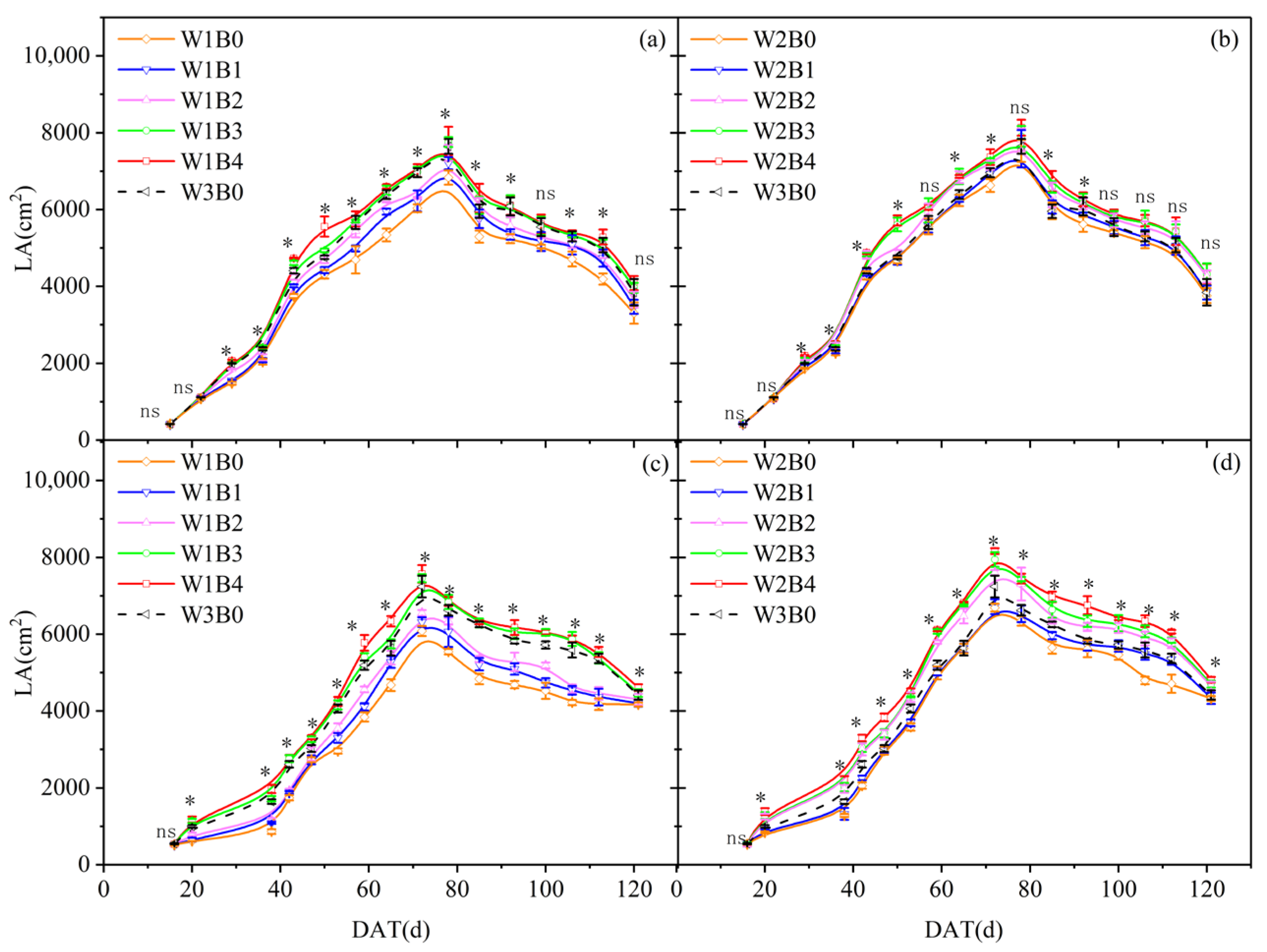
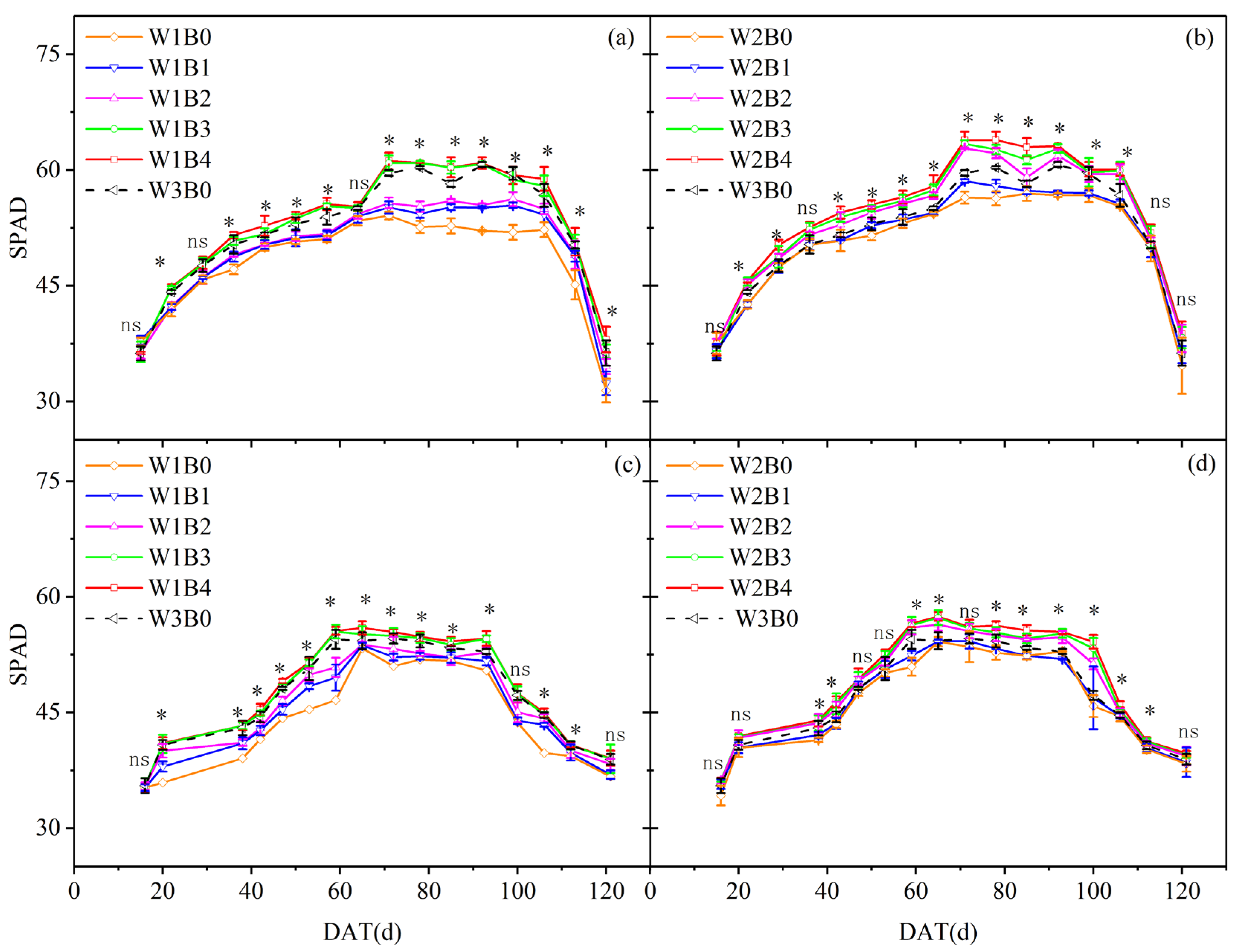
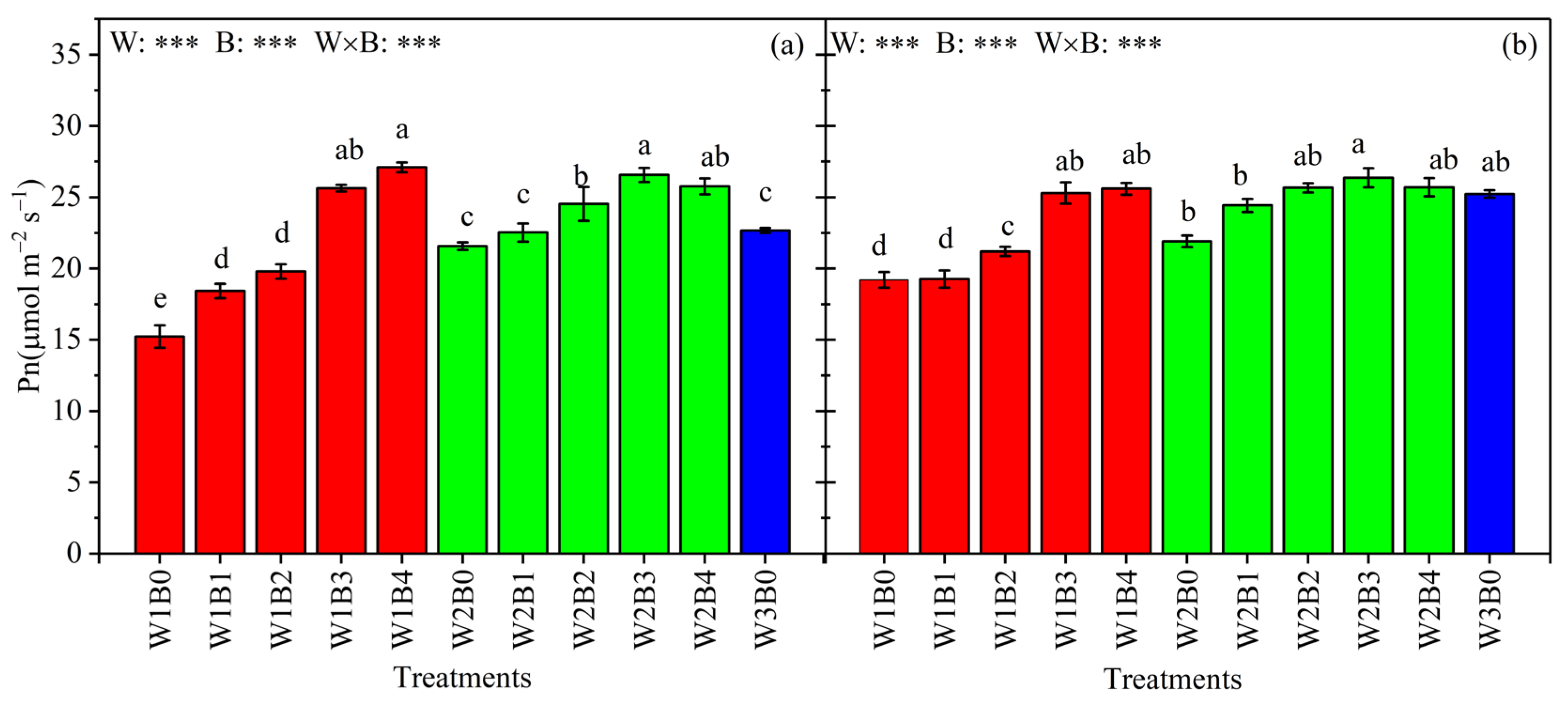
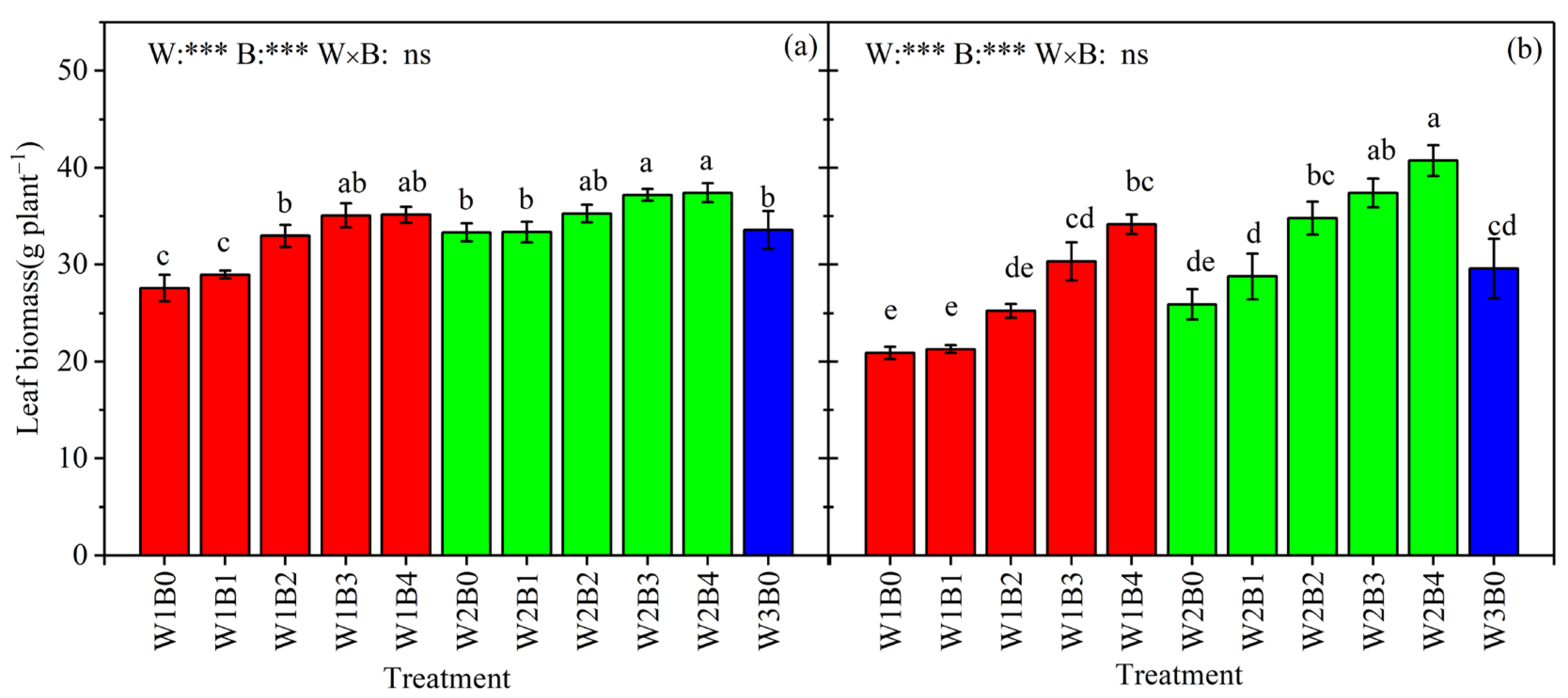
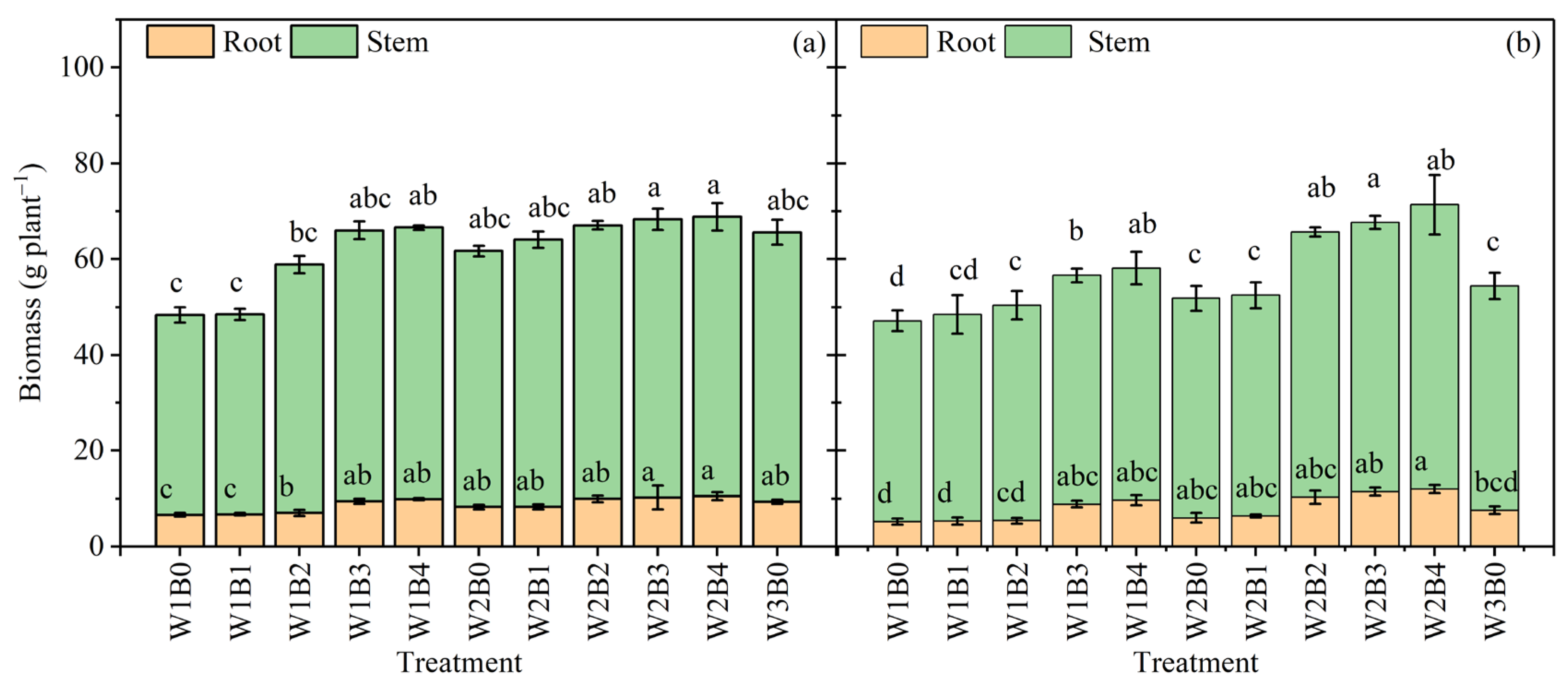

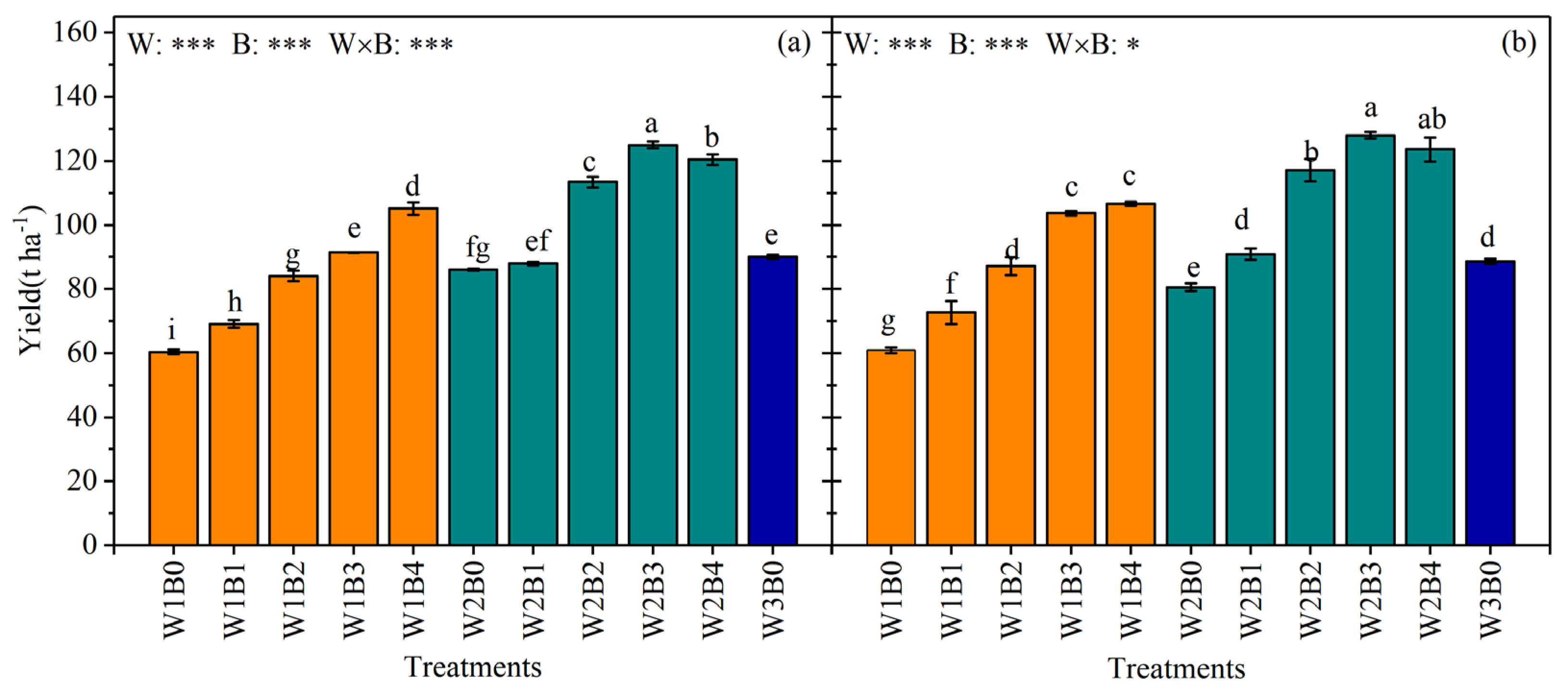
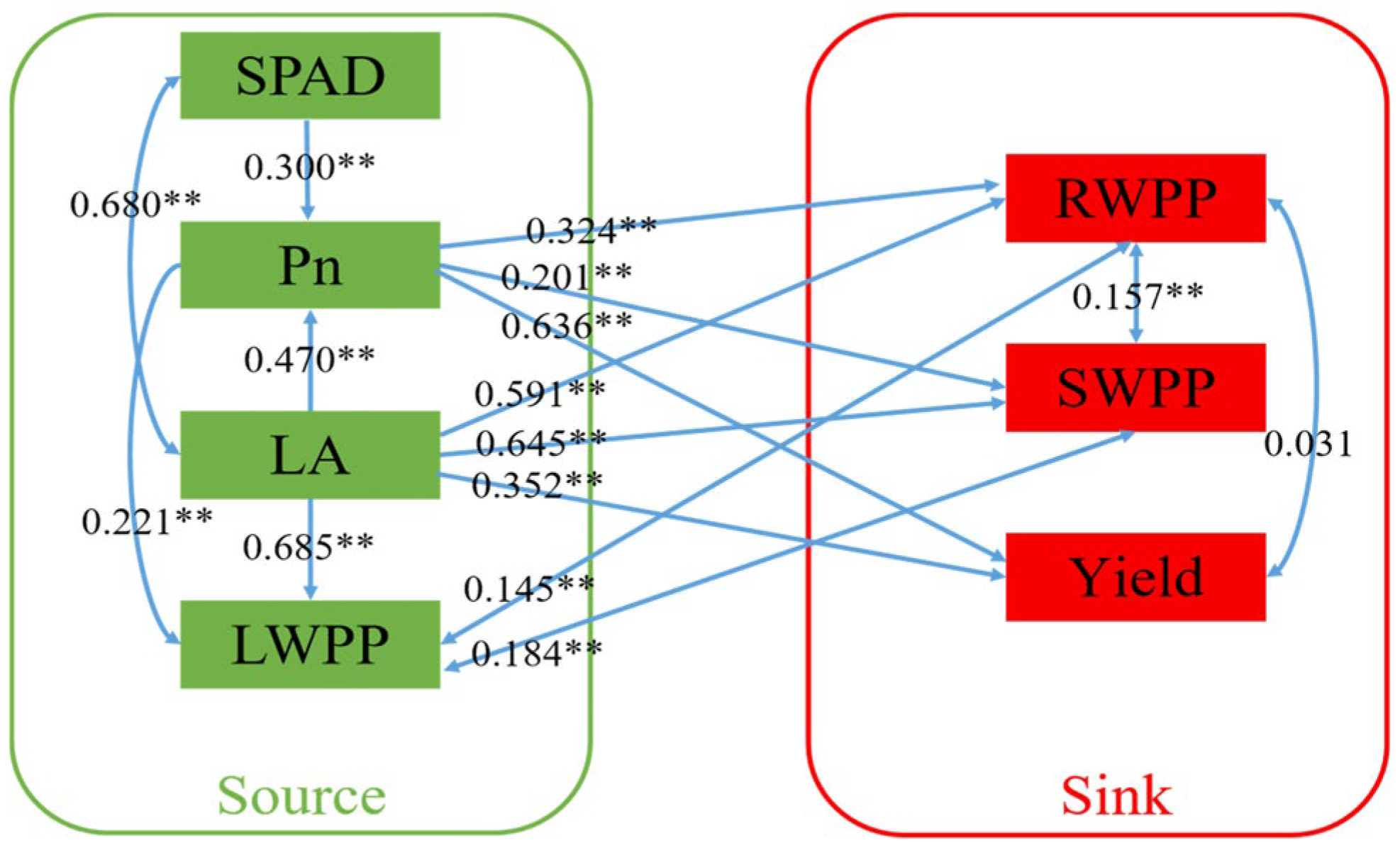
| Properties | Soil | Biochar |
|---|---|---|
| Texture | Silty loam | – |
| Field capacity (cm3 cm−3) | 0.38 ± 0.13 | – |
| Bulk density (g cm−3) | 1.45 ± 0.01 | – |
| pH | 8.39 ± 0.07 | 9.00 ± 0.06 |
| Organic matter (g/kg) | 26.86 ± 5.45 | 925.70 ± 5.03 |
| Total N (g/kg) | 1.44 ± 0.22 | – |
| Total P (g/kg) | 0.67 ± 0.06 | – |
| Total K (g/kg) | 42.98 ± 0.41 | – |
| Mass fraction of carbon (%) | – | 47.20 ± 2.49 |
| Mass fraction of nitrogen (%) | – | 0.70 ± 0.05 |
| Mass fraction of hydrogen (%) | – | 3.80 ± 0.35 |
| C/N | – | 67.87 ± 4.89 |
| Irrigation Level | Biochar Application Rate/t ha−1 | |
|---|---|---|
| W1B0 | 50–70% θf | 0 |
| W1B1 | 50–70% θf | 15 |
| W1B2 | 50–70% θf | 30 |
| W1B3 | 50–70% θf | 45 |
| W1B4 | 50–70% θf | 60 |
| W2B0 | 60–80% θf | 0 |
| W2B1 | 60–80% θf | 15 |
| W2B2 | 60–80% θf | 30 |
| W2B3 | 60–80% θf | 45 |
| W2B4 | 60–80% θf | 60 |
| W3B0 | 70–90% θf | 0 |
| 2021 | 2022 | |||||
|---|---|---|---|---|---|---|
| WPF (g Fruit−1) | FNPP | FWPP (g Plant−1) | WPF (g Fruit−1) | FNPP | FWPP (g Plant−1) | |
| W1B0 | 0.4 ± 0.02 b | 20.9 ± 0.97 a | 8.6 ± 0.12 e | 0.4 ± 0.02 e | 23.9 ± 0.64 a | 9.3 ± 0.76 d |
| W1B1 | 0.4 ± 0.03 b | 20.6 ± 1.02 a | 8.8 ± 0.16 e | 0.5 ± 0.03 de | 24.4 ± 0.23 a | 10.9 ± 0.71 cd |
| W1B2 | 0.5 ± 0.01 ab | 20.5 ± 1.07 a | 10.7 ± 0.74 d | 0.5 ± 0.02 cd | 25.0 ± 1.26 a | 12.3 ± 0.40 c |
| W1B3 | 0.6 ± 0.03 ab | 20.4 ± 1.41 a | 11.7 ± 0.49 bcd | 0.6 ± 0.03 ab | 24.2 ± 0.64 a | 15.1 ± 0.37 b |
| W1B4 | 0.6 ± 0.02 a | 20.5 ± 1.55 a | 12.9 ± 0.63 abc | 0.7 ± 0.02 a | 23.1 ± 0.67 a | 16.5 ± 0.57 ab |
| W2B0 | 0.6 ± 0.02 ab | 20.4 ± 0.59 a | 11.2 ± 0.17 cd | 0.5 ± 0.01 cd | 23.1 ± 0.54 a | 11.6 ± 0.40 c |
| W2B1 | 0.5 ± 0.06 ab | 21.0 ± 1.04 a | 11.2 ± 0.83 cd | 0.6 ± 0.02 bc | 23.4 ± 0.99 a | 13.0 ± 0.51 c |
| W2B2 | 0.7 ± 0.12 a | 20.9 ± 2.63 a | 13.0 ± 0.58 ab | 0.7 ± 0.04 a | 24.2 ± 0.60 a | 16.6 ± 1.31 ab |
| W2B3 | 0.7 ± 0.08 a | 20.3 ± 1.38 a | 14.2 ± 0.72 a | 0.7 ± 0.03 a | 25.3 ± 0.54 a | 17.6 ± 0.84 a |
| W2B4 | 0.7 ± 0.05 a | 21.53 ± 0.68 a | 13.8 ± 0.62 a | 0.7 ± 0.03 a | 24.5 ± 1.52 a | 16.8 ± 0.46 ab |
| W3B0 | 0.5 ± 0.03 ab | 21.5 ± 0.64 a | 11.6 ± 0.52 bcd | 0.5 ± 0.05 cd | 24.6 ± 0.90 a | 12.9 ± 0.66 c |
| W | * | ns | *** | *** | ns | *** |
| B | ** | ns | *** | *** | ns | *** |
| W × B | ns | ns | ns | * | ns | ns |
Disclaimer/Publisher’s Note: The statements, opinions and data contained in all publications are solely those of the individual author(s) and contributor(s) and not of MDPI and/or the editor(s). MDPI and/or the editor(s) disclaim responsibility for any injury to people or property resulting from any ideas, methods, instructions or products referred to in the content. |
© 2023 by the authors. Licensee MDPI, Basel, Switzerland. This article is an open access article distributed under the terms and conditions of the Creative Commons Attribution (CC BY) license (https://creativecommons.org/licenses/by/4.0/).
Share and Cite
Li, X.; Zheng, L.; Ma, J. Biochar Improves Greenhouse Tomato Yield: Source–Sink Relations under Deficit Irrigation. Agronomy 2023, 13, 2336. https://doi.org/10.3390/agronomy13092336
Li X, Zheng L, Ma J. Biochar Improves Greenhouse Tomato Yield: Source–Sink Relations under Deficit Irrigation. Agronomy. 2023; 13(9):2336. https://doi.org/10.3390/agronomy13092336
Chicago/Turabian StyleLi, Xufeng, Lijian Zheng, and Juanjuan Ma. 2023. "Biochar Improves Greenhouse Tomato Yield: Source–Sink Relations under Deficit Irrigation" Agronomy 13, no. 9: 2336. https://doi.org/10.3390/agronomy13092336
APA StyleLi, X., Zheng, L., & Ma, J. (2023). Biochar Improves Greenhouse Tomato Yield: Source–Sink Relations under Deficit Irrigation. Agronomy, 13(9), 2336. https://doi.org/10.3390/agronomy13092336




